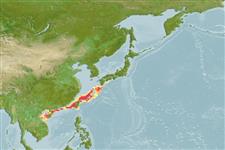Environment: milieu / climate zone / depth range / distribution range
Écologie
marin. Temperate
Northwest Pacific: Taiwan.
Taille / Poids / Âge
Maturity: Lm ? range ? - ? cm
Max length : 4.3 cm TL mâle / non sexé; (Ref. 31443)
Description synthétique
Clés d'identification | Morphologie | Morphométrie
Body in formalin yellowish throughout the body with black dots on the back; fins hyaline. Deciduous thin scales.
Life cycle and mating behavior
Maturities | Reproduction | Spawnings | Egg(s) | Fecundities | Larves
Shen, S.C., 1960. Bregmaceros lanceolatus and Bregmaceros pescadorus, two new species of dwarf fishes from southern Taiwan and Pescadore Islands. Q. J. Taiwan Mus. 13 (1-2):67-74. (Ref. 31443)
Statut dans la liste rouge de l'IUCN (Ref. 130435)
Menace pour l'homme
Harmless
Utilisations par l'homme
Outils
Articles particuliers
Télécharger en XML
Sources Internet
Estimates based on models
Preferred temperature (Ref.
123201): 16.5 - 23.5, mean 20.7 °C (based on 69 cells).
Phylogenetic diversity index (Ref.
82804): PD
50 = 0.5001 [Uniqueness, from 0.5 = low to 2.0 = high].
Bayesian length-weight: a=0.00372 (0.00152 - 0.00908), b=3.19 (2.97 - 3.41), in cm total length, based on LWR estimates for this (Sub)family-body shape (Ref.
93245).
Niveau trophique (Ref.
69278): 3.1 ±0.3 se; based on size and trophs of closest relatives
Fishing Vulnerability (Ref.
59153): Low vulnerability (10 of 100).
